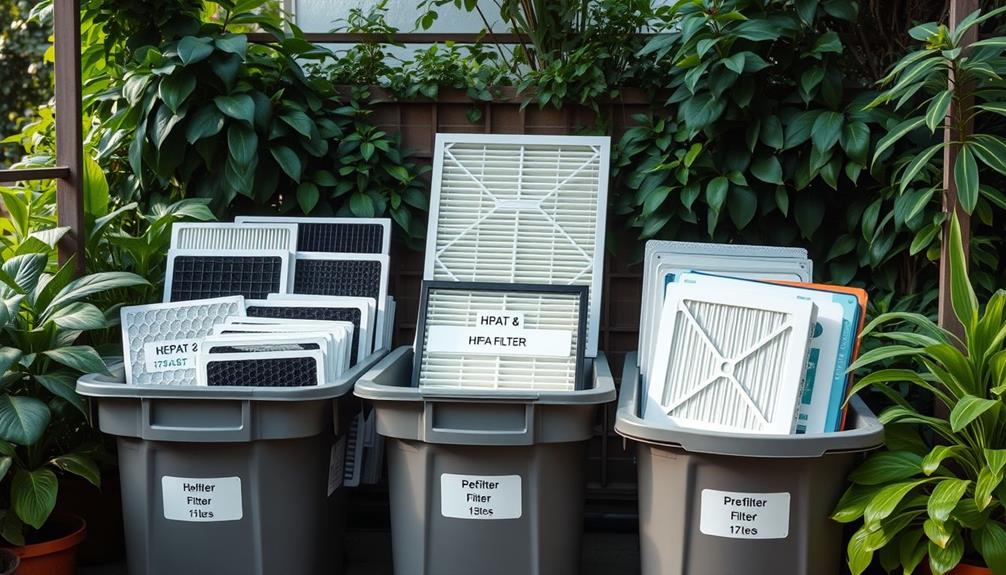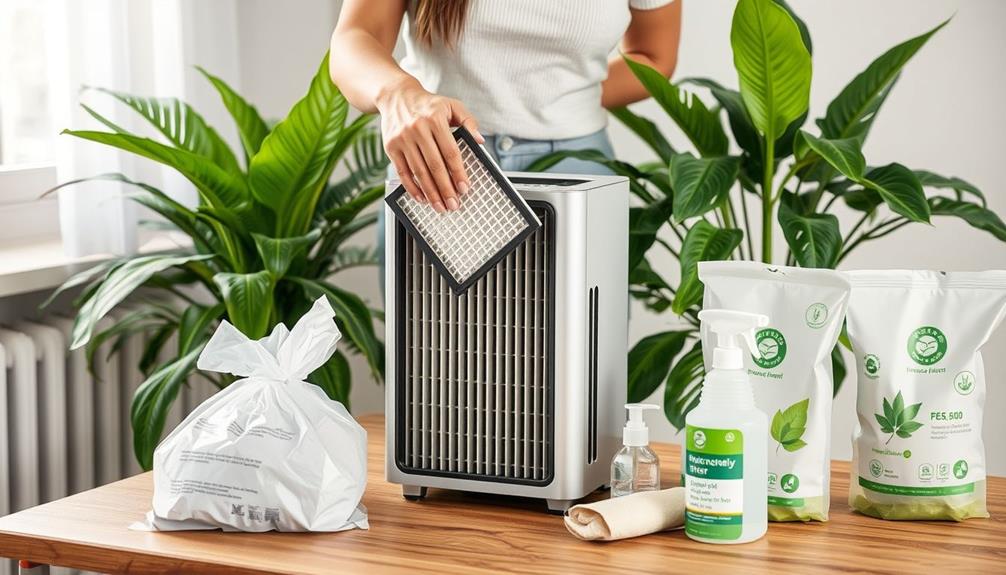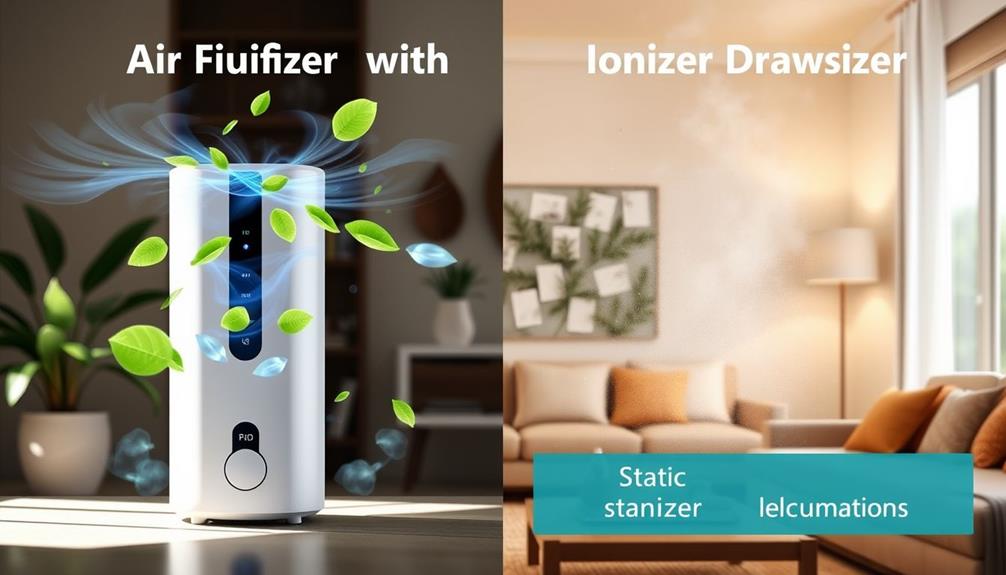Disposing of air purifier filters doesn't have to harm the environment. Start by sealing used filters in plastic bags to contain allergens. Check with your local waste management for recycling options since some filters, like HEPA, can be tricky. Non-recyclable filters should go in the regular trash, but look for biodegradable options that break down faster. Consider reusable or washable filters to cut back on landfill waste. These alternatives can last longer and save you money. Curious about more sustainable practices you can adopt? There's a lot more to explore on this topic.
Key Takeaways
- Regularly replace air filters every 1-3 months to maintain air quality and reduce environmental impact.
- Seal used filters in plastic bags to contain allergens and prevent contamination before disposal.
- Check local recycling guidelines, as specific air filters may have unique disposal options.
- Opt for biodegradable filters that break down more easily than traditional non-biodegradable options.
- Consider using reusable or washable filters to significantly reduce landfill waste over time.
Proper Disposal Methods
When it comes to disposing of air purifier filters, following proper methods is essential for both your health and the environment. Regularly replacing your air filters every 1-3 months helps maintain ideal air quality while reducing environmental impact.
For instance, using ozone air purifiers may reduce the frequency of filter changes due to their effective allergen and odor elimination. Before disposal, seal your used air filters in plastic bags. This step contains allergens and particulates, preventing contamination of other waste.
It's vital to check with local waste management for specific recycling guidelines since not all air filters are recyclable. Disposing of non-recyclable filters in regular trash is necessary, but be sure to adhere to local regulations. Improper disposal can lead to increased landfill waste, harming the environment.
If you have access to biodegradable filters, consider using them as they offer a more sustainable disposal option compared to traditional air filters. These biodegradable filters break down more easily, contributing to less waste in landfills.
Recycling Options by Filter Type

Understanding the recycling options for various air filter types can greatly impact your waste management efforts. By knowing how to properly dispose of your air filters, you can reduce your environmental footprint and contribute to filter recycling initiatives.
Additionally, choosing eco-friendly cleaning products can further support your sustainability goals, as highlighted in key factors in choosing a home cleaning service.
Here's a quick guide to help you navigate the recycling options:
- HEPA Filters: These filters are primarily made of fiberglass, making them difficult to recycle. However, some local recycling centers may accept them if you disassemble them first.
- Polyester Filters: While typically non-recyclable, the cotton components in polyester pleated filters can be recycled. This helps reduce overall resource demand, so check if your local recycling facility accepts these materials.
- Carbon and Aluminum Filters: Carbon filters need metal and plastic components removed before disposal; otherwise, they can't be recycled. Aluminum filters, including electrostatic ones, should go in regular trash as they're not recyclable.
Always check with your local recycling guidelines to verify you're following proper disposal methods for your air filters. By doing so, you're making a positive impact on the environment!
Environmental Impact of Filters

Air filters, often overlooked in waste management discussions, have a significant environmental impact that can't be ignored. Millions of HEPA filters are tossed out each year, contributing to landfill waste and taking up to 500 years to decompose.
Their non-biodegradable materials can lead to hazardous environmental contamination, as dangerous substances may leach into soil and water supplies. By fostering a culture of creativity and experimentation in sustainable practices, we can explore solutions that align with design thinking principles.
Many non-HEPA filters, made from recyclable materials, also end up in landfills due to a lack of consumer awareness and local recycling options. You can help mitigate this issue by advocating for sustainable disposal practices and supporting innovations in the recycling process.
When you choose to recycle air filters, you not only reduce landfill waste but also lower the carbon footprint associated with producing new filters.
Maintenance and Replacement Tips

Maintaining your air purifier is essential for guaranteeing it operates efficiently and keeps your indoor air quality at its best. Regular maintenance helps you avoid clogged air filters, which can increase energy consumption and lead to higher utility bills.
Following proper maintenance practices can also contribute to a safer home environment, similar to how home security systems protect against intrusions.
Follow these tips for effective maintenance and replacement:
- Regular Replacement: Change your air filters every 1-3 months, depending on the type—HEPA or washable filters. This keeps your purifier running smoothly and guarantees the materials used in the filters work effectively.
- Use Reminders: Set calendar alerts or use apps to remind you when it's time to replace filters. This simple step helps prevent issues related to filter lifespan and airflow.
- Care for Washable Filters: If you have washable filters, vacuum them on a low setting to extend their lifespan. Make sure they dry completely before reinserting them to avoid mold growth.
Store spare filters in a cool, dry place and check for expiration dates.
Proper maintenance not only enhances your air purifier's performance but also promotes eco-friendly disposal when the time comes to recycle or throw away used filters in the regular trash.
Alternatives to Disposable Filters

When it comes to choosing air filters, you have several eco-friendly alternatives to disposable options that can enhance both your indoor air quality and your wallet. Two popular choices are reusable air filters and washable filters. Reusable air filters can last up to five years, made from durable materials that contribute to long-term cost savings. On the other hand, washable filters can be cleaned and reused, helping you reduce landfill waste considerably. However, proper maintenance is essential to avoid mold growth and guarantee they don't harbor allergens.
Here's a quick comparison of these options:
| Filter Type | Benefits |
|---|---|
| Reusable Air Filters | Long-lasting, cost-effective, sustainable |
| Washable Filters | Reduces landfill waste, air purifying |
| Innovative Designs | Incorporate biophilic elements for aesthetics |
| Maintenance | Requires cleaning to prevent allergens |
| Suitability | May not suit those with severe allergies |
Conclusion
When you think about air purifiers, you might picture cleaner air but also the waste they create. By choosing eco-friendly disposal methods, you can enjoy fresh air without harming the planet. Recycling options vary by filter type, and understanding their environmental impact can help you make informed choices. Remember, regular maintenance prolongs filter life, and exploring alternatives to disposable filters might just be the key to a sustainable future. Breathe easy while being kind to Earth!









